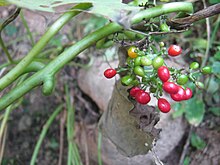
Summary
Cissampelos pareira (velvetleaf)[1] is a species of flowering plant in the family Menispermaceae.
| Velvetleaf | |
|---|---|

| |
| Cissampelos pareira with fruits found in Panchkhal, Nepal | |
| Scientific classification | |
| Kingdom: | Plantae |
| Clade: | Tracheophytes |
| Clade: | Angiosperms |
| Clade: | Eudicots |
| Order: | Ranunculales |
| Family: | Menispermaceae |
| Genus: | Cissampelos |
| Species: | C. pareira
|
| Binomial name | |
| Cissampelos pareira | |

Morphology edit
It is a slender tomentose climber. The leaves are peltate, 2.5–12 cm long, 2.5–11.5 cm broad, triangularly broad-ovate, or orbicular, obtuse, mucronate, base cordate or truncate, ± tomentose on both sides; petiole pubescent. Flowers are small in size, pedicels filiform. Male flowers clustered in the axil of a small leaf; sepals are 4 in number, obovate-oblong, hairy outside; petals 4 in number, united to form a 4-toothed cup, hairy outside; stamens 4, column short, anthers connate, encircling the top of the column. Female flowers clustered in the axils of orbicular, hoary imbricate bracts, on 5–10 cm long racemes; sepal 1, petal 1; carpel 1, densely hairy; style shortly 3-fid. Drupe 4–6 mm long, 3–4 mm broad, subglobose, compressed, hairy-pubescent, red when fresh, black when dry, endocarp transversely ribbed, tuberculate. Seeds are horseshoe-shaped.[2]
Medicinal uses edit
Cissampelos pareira is used in Chinese herbology, where it is called xí shēng téng (Chinese: 锡生藤) or yà hū nú (Chinese: 亞乎奴). The species is also known as abuta and called laghu patha in Ayurvedic medicine. In Tamil Nadu it is called ponmusutai and it is used for a number of medicinal purposes.
Some attention has been paid to it in Kenya, Tanzania, and other places for its purported antimalarial properties in particular,[3][4] as well as in India for its antiviral properties, especially against Dengue virus.[5]
See also edit
References edit
- ^ a b "Cissampelos pareira". Germplasm Resources Information Network. Agricultural Research Service, United States Department of Agriculture. Retrieved 2008-02-05.
- ^ "Velvetleaf - Encyclopedia of Life".
- ^ Muthaura, C.N.; Rukunga, G.M.; Chhabra, S.C.; Mungai, G.M.; Njagi, E.N.M. (2007). "Traditional phytotherapy of some remedies used in treatment of malaria in Meru district of Kenya". South African Journal of Botany. 73 (3): 402–411. doi:10.1016/j.sajb.2007.03.004.
- ^ Taylor, Leslie (1996). "Tropical Plant Database entry for: ABUTA – Cissampelos pareira". www.rain-tree.com. Retrieved 2014-07-22.
- ^ Beasley, David W.C.; Sood, Ruchi; Raut, Rajendra; Tyagi, Poornima; Pareek, Pawan Kumar; Barman, Tarani Kanta; Singhal, Smita; Shirumalla, Raj Kumar; Kanoje, Vijay; Subbarayan, Ramesh; Rajerethinam, Ravisankar; Sharma, Navin; Kanaujia, Anil; Shukla, Gyanesh; Gupta, Y. K.; Katiyar, Chandra K.; Bhatnagar, Pradip K.; Upadhyay, Dilip J.; Swaminathan, Sathyamangalam; Khanna, Navin (2015). "Cissampelos pareira Linn: Natural Source of Potent Antiviral Activity against All Four Dengue Virus Serotypes". PLOS Neglected Tropical Diseases. 9 (12): e0004255. doi:10.1371/journal.pntd.0004255. PMC 4692392. PMID 26709822.
External links edit
- List of Chemicals in Cissampelos pareira (Dr. Duke's Databases) Archived 2021-09-18 at the Wayback Machine


